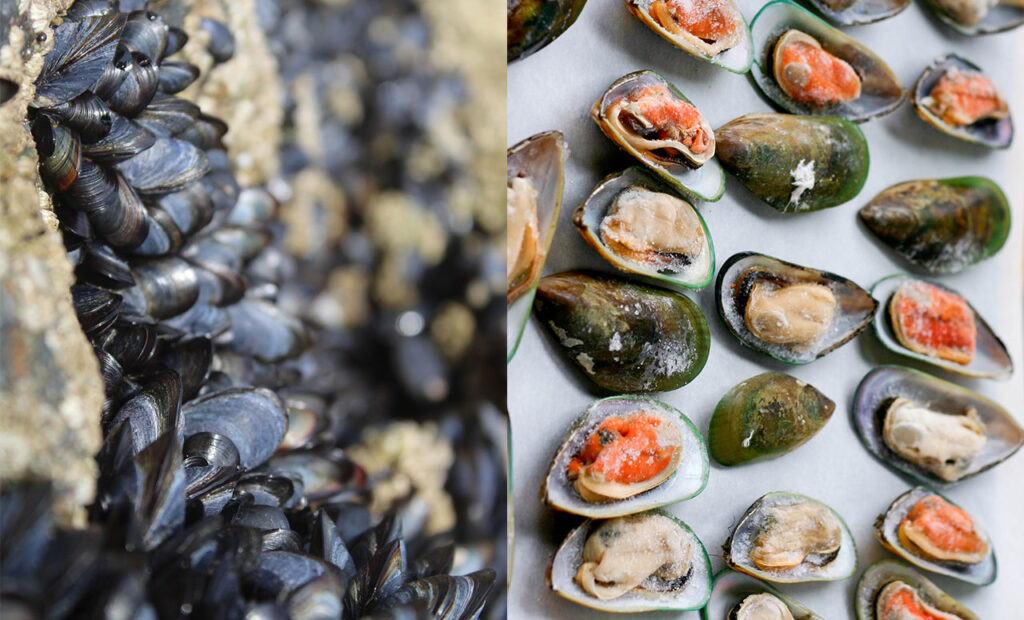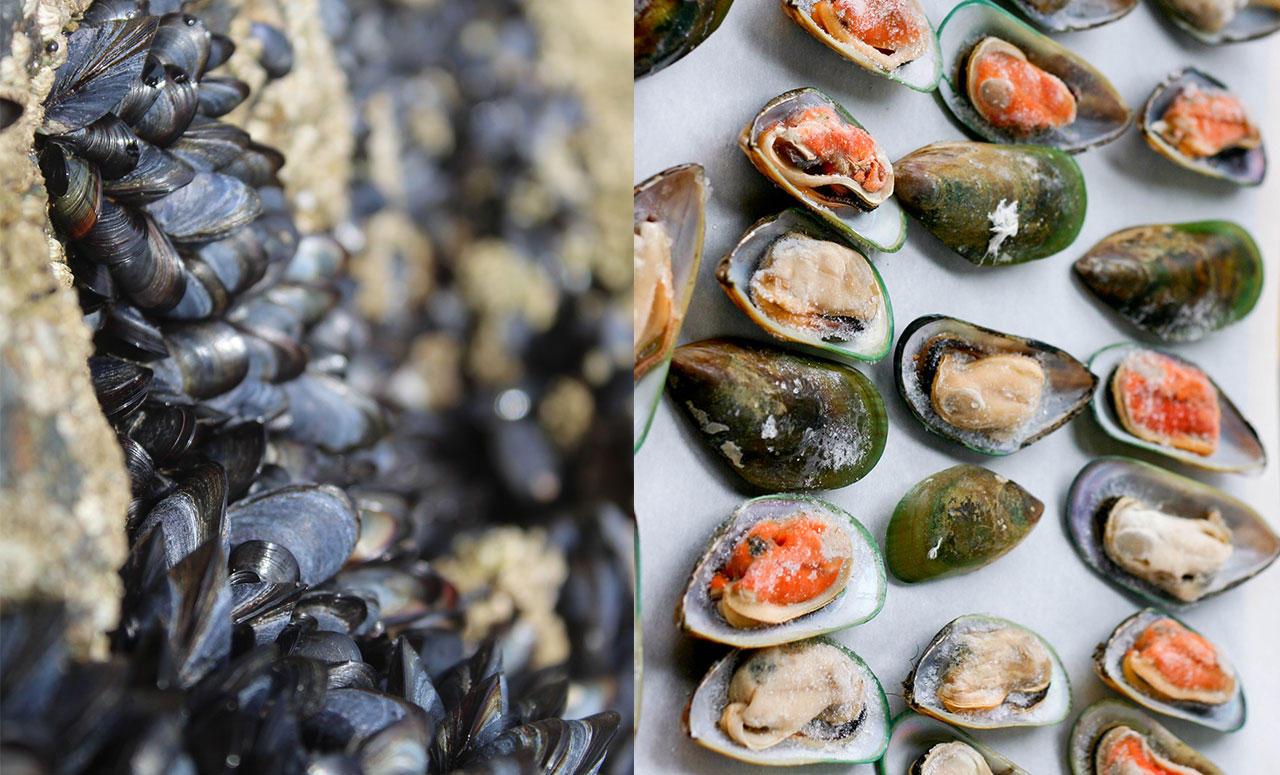What is the difference between green mussels and black mussels? The main difference between green mussels and black mussels is the size and colors of the mussels. They are named after their black shell, while green mussels are named after their gray-green shell. Additionally, green mussels are twice as large, making them more expensive. The taste is similar in both green and black mussels.
- Comparison of Green Mussels vs Black Mussels
- What Are Black Mussels
- Farming
- Specifications of Black Mussels
- Cost and Availability
- What Are Green Mussels
- Farming
- Specifications of Green Mussels
- Cost and Availability
- What to Look For When Buying Mussels
- What’s The Difference Between Them?
- Cooking Green and Black Mussels
- Interesting Facts & Questions
- Are Green or Black Mussels Better?
- Are Green Mussels Good?
- What Do Green Mussels Taste Like?
- What Are Green Mussels Good For?
- Are Green-Lipped Mussels Good For Arthritis?
- Why is The Green Mussel Harmful?
- Why Are Mussels Green?
- Where Do Green Mussels Come From?
- Is There Iodine in Green-Lipped Mussels?
- Can Dogs Overdose On Green-Lipped Mussel?
- Can Dogs Eat Green Mussels?
- Are Black Mussels Good?
- Are Black Mussels Safe to Eat?
- Can You Eat Black Mussels NZ?
- Do Vegans Eat Mussels?
- What Part of Mussel is Not Edible?
- Why Do Mussels Smell Like Poop?
- Are Mussels Dead If They Float?
- What Eats Mussels in The Ocean?
- What’s Inside Black Mussels?
- Are Black Mussels Healthy?
- Are New Zealand Mussels Safe to Eat?
- Can You Eat Raw Mussels?
- Is Mussels Good For Your Health?
- Do Mussels Feel Pain?
- Do Mussels Have Hearts?
- How Do You Tell if Mussels Are Cooked?

Everyone loves seafood, and there are plenty of choices available! They’re nutritious, delicious, and highly versatile that can be used with various tastes!
Mussels are a top-rated seafood product; however, most people have heard of black mussels. What? Are there different kinds of a mussel? Yes, indeed! The green-lipped mussels are also widespread!
Today, we’ll examine the differences between green mussels vs black mussels and how they differ in how they are raised and their availability, which determines the cost and use of black mussels vs green mussels.
Comparison of Green Mussels vs Black Mussels
| Comparison | Green Mussels | Black Mussels |
| Originate from | New Zealand, Pacific Rim, Western Shores of North and South America | The Pacific Ocean and the Atlantic Ocean |
| Countries now found in | New Zealand, and India recently | Canada, China, South Africa, and the United States |
| Cultivation | In the wild, and in India – farmers cultivate in deep waters | In the wild |
| Also known as | Green-lipped mussel | Blue mussel |
| Color | Gray shell | Deep dark blueish shell |
| Green lip and hues | A shade of black throughout | |
| Shape | Traditional shape, but larger | Traditional shape |
| Availability | All year, but harder to source | All year |
| How fast do they reproduce? | Slow | Very fast |
| What size are they? | Averages | Averages |
| 6 inches long | 2.5 inches long | |
| Taste | Less intense flavor | Very intense flavor |
| Very distinct taste | Slightly sweet | |
| Texture | Tender | Soft |
| Very chewy | Tender texture | |
| Cost of mussel (2022) | Expensive | Reasonable |
| $12-$15 per 2llb bag | $5-$8 per 2llb bag | |
| Can they be chilled or frozen? | Yes | Yes |
| Can they be marinated or flavored? | Yes | Yes |
| Dangerous to eat? | Yes, once prepared and cooked correctly, it’s safe | Yes, once prepared and cooked correctly, it’s safe |
| Can you eat raw? | Yes, but raw mussels need marinating. | Yes, but raw mussels need marinating. |
| Nutritional sources | High levels of protein, omega-3 fat, zinc, folate, iodine, iron, and selenium. | High levels of protein, omega-3 fat, zinc, folate, iodine, iron, and selenium. |
| Length of cooking time | 10-12 minutes | 5-7 minutes |
| What temperature is the best for cooking? | High heat | High heat |
| Over 167°f | Over 167°f | |
| Can you batter mussels? | No | No |
| Can you pan fry mussels? | Yes | Yes |
| Can you oven cook mussels? | Yes | Yes |
| Can you steam mussels? | Yes | Yes |
| What is best served with? | Mussels, fennel, saffron, and white wine. | Mussels, cream, curry, and saffron. |
| Is it gluten-free? | Yes | Yes |
| Is it vegan? | No | No |
Read on and take an in-depth look at the differences and how you can safely prepare mussels, how to steam mussels, and other ways to cook them in your kitchen at home!
What Are Black Mussels
Black mussels are perhaps the most widely-known and consumed mussel species. They are among the two species found throughout the U.S., the other being the green mussel.
They are often mistaken for blue mussels due to their resemblance, but they’re distinct.
Blue mussels have a blueish color, whereas black mussels are black. Their shapes and sizes closely resemble one the other, and to distinguish them; you must look at the color of their shells.
Black mussels are abundant on the Pacific and Atlantic coasts, where cooler temperatures. Some of the countries that have the most aquaculture-intensive mussels are South Africa, Canada, China, and the United States.
Farming
The mussels are cultivated in the wild, typically grown naturally to be harvested. Ropes are suspended from tightly packed areas to ensure that mussels can develop on them.
Another reason is that black mussels are more frequent than green mussels. If they grow naturally and require little effort, they can produce more significant amounts.
Specifications of Black Mussels
Black mussels are the most commonly used; therefore, you already know their appearance. Their size averages approximately 2.5-inches long, but it can depend on where you purchase them from.
Black mussels are incredibly intense in their taste that is not matched with other varieties. They also have a tender and soft texture, chewier than green mussels.
Cost and Availability
Black mussels are found all over the world. This is partly due to the way they are kept and their natural habitat.
They can be found freshly frozen or in a variety of varieties. They can be as a whole, half-shelled, or even as a single piece of mussel (meaning there is no shell). It is also possible to see that they can be flavored or marinated.
The common mussels are the species that produce pickled or canned mussels.
Because it’s available all year long, the price is extremely reasonable and in some places even shockingly low!
What Are Green Mussels
As mentioned previously, green mussels are another popular species found within the U.S. and most other countries. Also, you will notice that they can be referred to by the name “Green Lipped Mussels.”
The mussels are native to New Zealand and regions in the Pacific Rim (the Western shores in North and South America). However, several countries, such as India, have begun cultivating these mussels in open water.
Farming
Since these mussels originate from New Zealand, many countries raise them independently. The regulations and restrictions are incredibly stringent and carefully observed. Farmers’ mussels need high-quality water and food.
Specifications of Green Mussels
The beautiful mollusk is the typical shape of mussels, but they’re much more prominent in dimensions, almost twice as larger than your standard white mussel. They’re about 6 inches in length, which naturally impacts the price.
The mussels are very hard-soft, chewy, and tender texture. It is evident that the flavor isn’t as strong compared to other species; however, they are still delicious, and some say they are slightly sweet.
Cost and Availability
Since these mussels are nearly only grown naturally within New Zealand or otherwise farmed, their price is considerably higher. They aren’t many, but they’re tricky to locate as black or blue mussels.
The bigger size means they are more expensive and their seasonality.
While challenging to find, these green mussels are also available either frozen or fresh and come in various forms, such as half shell, whole, and even with meat only.
What to Look For When Buying Mussels
When buying muscles, they should be bought fresh and still alive – a closed shell means it’s fresh and alive. Mussels are similar to many other shellfish, they spoil fast, so you should prepare and eat mussels on the day you purchase them, or you run the risk of food poisoning. This is very easy with mussels as they spoil quickly.
In order to store mussels correctly, put them into a bowl and place them into the refrigerator covered with a damp towel. Don’t store them in a bowl of water, especially tap water, as this will kill them very quickly and it will stink your refrigerator.
What’s The Difference Between Them?
Having reviewed the various seafood products separately, let’s examine their characteristics.
Most importantly, the color of their fur is what differentiated the two species the most.
Green-lipped mussels sport an evident grey shell adorned with gorgeous green hues. A deep and dark blue shell characterizes the black mussels.
Another characteristic that sets them apart from one another is their dimensions. Green mussels tend to be larger than the standard black mussel. However, they can both differ in size.
Black mussels are known for their soft and tender texture, and green mussels are known for their slightly chewier texture.
In terms of their taste, like every ingredient, it all comes down to individual taste, and neither one is “better” compared to the other. Black mussels possess a vibrant and sweet taste, and green mussels don’t have as much of a presence.
Read also: What to Serve With Chilli Chicken
The method in which mussels are raised also differs significantly. Mussels of black are cultivated in their natural habitat by ropes, making them quick and simple to catch.
They are also located in many regions around the globe where they are abundant.
Green mussels are, however, extremely rare, despite being quite common. Their rarity is that they are only naturally occurring in New Zealand and some coasts in South and North America.
The raised green-lipped mussels are farmed and are therefore more expensive to make, hence the higher cost.
Considering they’re pretty popular, both of these varieties are available either in fresh or frozen form. In regions where they aren’t growing or being raised in any way or other, you’ll discover that frozen varieties are easier to locate.
In the local regions where they are plentiful, You will notice that you can quickly locate both frozen and fresh versions, of which the fresh varieties are just a little more costly.
In the next step, you’ll discover the entire mussels and half-shells and the meat of the mussel in frozen and fresh versions. Also, you can find them in canned or pickled forms and in a range of refreshing and tasty flavor combinations.
Cooking Green and Black Mussels
When we examine the way each one can be used and how they’re used, they’re in a way interchangeable. Their tastes and textures are similar enough that it is possible to pick either due to the availability, price, and aesthetic appearance.
People consume mussels for two reasons: diet and health or simply because it’s delicious.
Mussels offer numerous health benefits and are a great choice as part of a pescatarian diet. They’re high in nutritious and healthy proteins and omega-3 fatty acids, and many vitamins and minerals.
The most commonly used method to cook almost any mussels is to steam them in half-shells or whole and pan-fry the mussel meat.
Green-lipped and black mussels are great with the same components for flavor. The most flavorful accompaniments to seafood are always fresher and more flavorful, like lemon juice, zest, fresh olive oil, fresh herbs, and even pickled items.
Garlic and wine are an effective and classic combination of flavors that wonderfully improve mussels’ natural taste.
The most creative ideas for mussels recipes are steam garlic, fennel, and wine mussels. There are also deep-fried, herb-crusted meats of mussels or some baked, cheesy mussels.
Steaming Green and Black Mussels
If you are cooking mussels, it is possible to use any available mussels. Most often, the whole and half shell mussels are cooked. However, the meat of mussels can be steamed to preserve the nutrients.
Both species of mussels are cooked in the same way. However, their cooking times will differ. Since green mussels are naturally larger, they need to cook longer than black mussels.
Black mussels can cook for around 7 minutes, and green mussels need to cook for between 10 and 12 minutes.
Steaming mussels is an excellent cooking technique that can help its meat retain its flavor, moisture, and nutrients and enhance the mussels’ color.
Steaming is also a great way to blend flavors of other ingredients, such as wine and garlic, herbs, and onion. You can find a variety of flavor options to play with.
How to Steam Mussels
- Sauté any vegetable or spices, aromatics, herbs, or vegetables you’d like to add.
- Then, add the mussels into the pot and immediately add the water base. It could be stock, broth wine, wine, or simply water.
- Cover the pan or pot with the lid and let the black mussels cook for around five minutes and the green mussels for about 10-minutes.
- Take off the lid and examine if most lids have opened, indicating that they’re fully cooked. If they’re still not ready, place the top on the pot and cook for two or three minutes.
- Serve it warm and preferably with cooking liquid. Garnish with fresh herb and zest.
Pan-Fried Green Mussels and Black Mussels
Another excellent and widespread method to cook mussels is to pan-fry the mussel’s meat. This allows them to let the flavors of the meat out and gives them a smokey note.
The most simple mussels to cook in a pan are ones that do not have shells. However, there are recipes for sautéing whole mussels added to a base sauce to further cook after opening.
The shells themselves have beautiful flavors that can be added to dishes.
Pan-frying mussels must be cooked using an ingredient that is liquid or wet. This is to stop the mussels from drying out and sticking to the pan or overcooking. Nothing is more unpleasant than a rubbery, chewy mussel!
How to Pan-Fry Mussels
- Saute the main ingredients such as garlic, vegetables, and herbs. Add spices, herbs, and other ingredients of your choice.
- Add a tablespoon of oil before adding all the mussels, and then toss them around for approximately two minutes. They should begin to pop open.
- Include your base liquid-like wine or broth, and cook them for a while until they’re fully released.
- Serve them immediately when they’re still hot and freshly cooked. You can garnish them with flavors that complement them, such as lemon or Dill.
Interesting Facts & Questions
After discussing the different types of characteristics of green and black mussels, we’ll look at some of the concerns we believe you’ve been thinking about when going through this piece!
Are Green or Black Mussels Better?
Black mussels are renowned for their silky and delicate texture. Green mussels are known to have a more tough texture, but they both taste equally the same. It comes down to your own preference of flavor and taste, so we can’t say one is better than the other.
Are Green Mussels Good?
Green mussels have high levels of anti-inflammatory nutrients with a great source of zinc, iron, B-vitamins, and selenium. Green-lipped mussels also contain anti-inflammatory nutrients, omega 3 fatty acids, and chondroitin sulfate. We can safely say, that green mussels are good and very nutritious for you.
What Do Green Mussels Taste Like?
Green mussels have a very mild flavor scented with a sweet, mushroom-esque undertone. Their flavor is indescribable if you are prone to seafood. They match perfectly with many ingredients and dishes.
What Are Green Mussels Good For?
The green-lipped mussels are stocked up in natural supplements and are proven to reduce joint pain and stiffness. You will regularly find green mussels in osteoarthritis supplements.
Are Green-Lipped Mussels Good For Arthritis?
Research by scientists shows that taking New Zealand green-lipped mussel extract by tablet supplements reduces symptoms of osteoarthritis, including pain and stiffness.
Why is The Green Mussel Harmful?
Green mussels are a natural place for parasites and diseases, the green-lipped mussels can gather toxic substances when they live and grow in polluted waters, which is common now. If you eat a contaminated green mussel it can cause Paralytic Shellfish Poisoning.
Why Are Mussels Green?
Inside the mussels, you may see black or green particles, which are the plankton and algae that the mussel didn’t digest. They aren’t dangerous, but they don’t taste particularly nice, it’s why you should always thoroughly rinse the mussels prior to serving.
Where Do Green Mussels Come From?
Green mussels were first discovered in the Caribbean in 1990. Green mussels are sourced in the ocean waters of the Indo-Pacific region, from India to Southeast Asia.
Is There Iodine in Green-Lipped Mussels?
Yes, green-lipped mussels contain many nutrients, including iodine.
Can Dogs Overdose On Green-Lipped Mussel?
Yes, supplements containing green-lipped mussels can be very harmful to your dog because of high levels of vitamins and can easily lead to an accidental overdose.
Can Dogs Eat Green Mussels?
Yes, dogs can eat green mussels. They are a great source of omega 3 fatty acids, protein, and vital minerals like zinc, iron, and manganese. The nutrition gives your dog loads of protein and ensures they maintain an active and healthy life.
Are Black Mussels Good?
Black mussels are equally as good as green mussels. They are jam-packed with nutrients such as omega 3 fatty acids, marine omega 3s, DHA, and EPA. These nutrients are valuable for keeping your blood pressure low, keeping your heartbeat regular, and enhancing an overall healthy heart
Are Black Mussels Safe to Eat?
Mussels harvested from authorized waters regulated and processed in hygienic conditions are safe for consumption.
Can You Eat Black Mussels NZ?
The popular black mussels are delicious, full of nutritious vitamins, and can be eaten the same as a green mussel, but they are expensive due to size and not being harvested often in New Zealand.
Do Vegans Eat Mussels?
No, mussels aren’t vegan. Since mussels are an animal, eating a mussel is not part of a vegan’s diet.
What Part of Mussel is Not Edible?
The two dark blue shells protect the edible meaty part of the mussel. One side of the mussel is an inedible fiber called byssal threads which chefs nickname the beard or tail. Interestingly, the mussel uses these threads to stay attached to a solid surface below water.
Why Do Mussels Smell Like Poop?
When mussels have died and start to rot, they begin to smell off and fishy. The more the mussel rots the worse it gets, it’s why it eventually smells horrid, similar to sewage or poo.
Are Mussels Dead If They Float?
If a green or black mussel floats, they are either dead or empty. However, it’s easy to find out, simply squeeze the mussel shut and it stays shut, the mussel is alive and fresh. If it starts to open, it’s best to put it in the garbage. Ps. don’t put mussels in tap water longer than 15 minutes or they will die.
What Eats Mussels in The Ocean?
Mussel’s main predators are seabirds, starfish, and unsurprisingly, us humans! Freshwater mussels are preyed on by otters, muskrats, ducks, geese, and humans.
What’s Inside Black Mussels?
Inside black mussels are small microscopic creatures like plankton which are eaten by the mussel and still in the digestive tract. It’s why you must properly prepare mussels to ensure any bacteria is killed by cooking them in piping hot water for 3-4 minutes.
Are Black Mussels Healthy?
Yes, black mussels are very healthy with a nutritious source of protein. Mussels are loaded with vitamins like omega 3 fatty acids, zinc, and folate. They are so highly enriched in vitamins that it exceeds the daily intake of selenium, iodine, and iron.
Are New Zealand Mussels Safe to Eat?
Yes, it is safe to eat. Like any shellfish, cook mussels in piping hot water for one minute to ensure they’re safe to eat. When they are cooked at a high temperature it kills any bacteria (Vibrio parahaemolyticus) in the mussels. A great way to know when mussels are fully cooked and ready to serve, their shells pop open when steamed or boiled, and the mussel inside is firm.
Can You Eat Raw Mussels?
Yes, you can eat raw mussels, provided they are properly prepared before serving.
Is Mussels Good For Your Health?
Yes, mussels are good for your health. They are a great source of protein and omega-3 fats. There are other nutrients like folate, zinc, iron, iodine, and selenium.
Do Mussels Feel Pain?
No, they don’t according to animal biologist researcher, Diana Fleischman.
Do Mussels Have Hearts?
Yes, mussels have a heart. They also have kidneys, stomach, mouth, and gills.
How Do You Tell if Mussels Are Cooked?
When your pot starts to steam, cook the mussels at high heat for 3-4 minutes and shake the pan occasionally. Check Great British Chefs tutorial on cooking mussels, you can’t go wrong!









